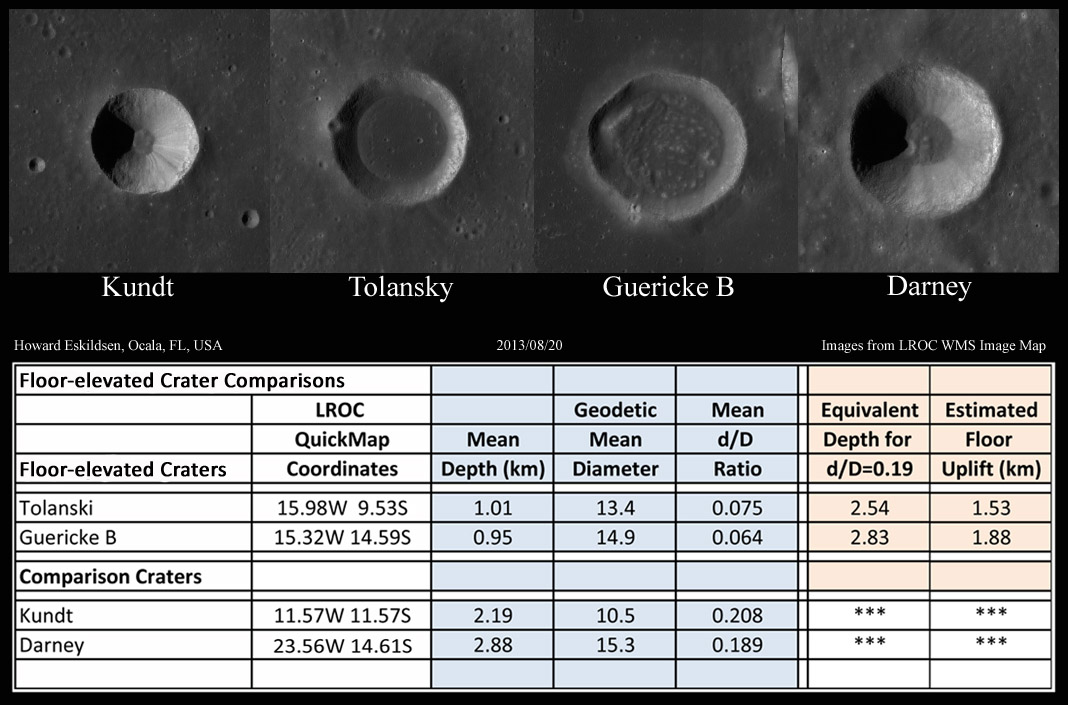Difference between revisions of "August 23, 2013"
| Line 6: | Line 6: | ||
<em>image by [mailto:howardeskildsen@msn.com Howard Eskildsen], Ocala, Florida</em><br /> | <em>image by [mailto:howardeskildsen@msn.com Howard Eskildsen], Ocala, Florida</em><br /> | ||
<br /> | <br /> | ||
| − | Here are measurements of the depths and diameters of [http://lpod. | + | Here are measurements of the depths and diameters of [http://www2.lpod.org/wiki/August_20,_2013 Guericke B], Tolansky as well as the non-modified craters Kundt and Darney. The latter two are in the same general area and have not had their floors elevated as the first two have. By estimating the first two craters original depths and comparing them with the current depths it can be calculated that Tolansky's floor may be 1.5 km higher than its original depth, while Guericke B's could be about 1.9 km higher than it once was. I like to think of them as floor-elevated craters. I can only think of three things that could elevate the floor to that degree: floor uplift by volcanic intrusion, floor elevation by volcanic extrusion ( or a combination of the two), and fill by fluidized ejecta. I do not believe that the latter was primarily involved here. Based on high sun illumination it is apparent that the interior of Tolansky is dark like mare basalt, while Guericke B's interior is brighter than surrounding basalt. This leads me to believe that Tolansky's elevated floor is due to extrusion (though some floor uplift may be buried beneath the basalt), while Guericke B's floor elevation is due to intrusion of magma beneath the floor with uplift and fracturing of the original floor.<br /> |
<br /> | <br /> | ||
<em>[mailto:howardeskildsen@msn.com Howard Eskildsen]</em><br /> | <em>[mailto:howardeskildsen@msn.com Howard Eskildsen]</em><br /> | ||
<br /> | <br /> | ||
<strong>Related Links</strong><br /> | <strong>Related Links</strong><br /> | ||
| − | <em>[ | + | <em>[[21st Century Atlas of the Moon|21st Century Atlas]]</em> charts 22 & 23.<br /> |
<br /> | <br /> | ||
<p><b>Yesterday's LPOD:</b> [[August 22, 2013|Streaks of Shadows And Rubble]] </p> | <p><b>Yesterday's LPOD:</b> [[August 22, 2013|Streaks of Shadows And Rubble]] </p> | ||
Latest revision as of 07:24, 28 October 2018
Floor-Elevated Craters

image by Howard Eskildsen, Ocala, Florida
Here are measurements of the depths and diameters of Guericke B, Tolansky as well as the non-modified craters Kundt and Darney. The latter two are in the same general area and have not had their floors elevated as the first two have. By estimating the first two craters original depths and comparing them with the current depths it can be calculated that Tolansky's floor may be 1.5 km higher than its original depth, while Guericke B's could be about 1.9 km higher than it once was. I like to think of them as floor-elevated craters. I can only think of three things that could elevate the floor to that degree: floor uplift by volcanic intrusion, floor elevation by volcanic extrusion ( or a combination of the two), and fill by fluidized ejecta. I do not believe that the latter was primarily involved here. Based on high sun illumination it is apparent that the interior of Tolansky is dark like mare basalt, while Guericke B's interior is brighter than surrounding basalt. This leads me to believe that Tolansky's elevated floor is due to extrusion (though some floor uplift may be buried beneath the basalt), while Guericke B's floor elevation is due to intrusion of magma beneath the floor with uplift and fracturing of the original floor.
Howard Eskildsen
Related Links
21st Century Atlas charts 22 & 23.
Yesterday's LPOD: Streaks of Shadows And Rubble
Tomorrow's LPOD: Leibnitz Mountains?
COMMENTS?
Register, Log in, and join in the comments.



